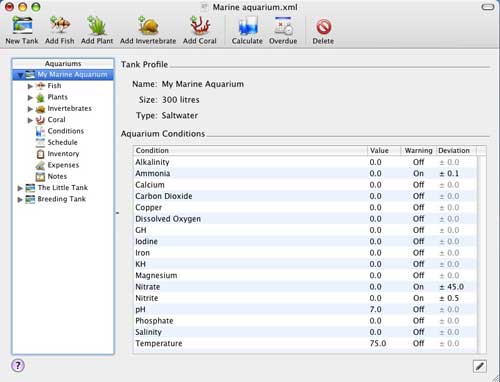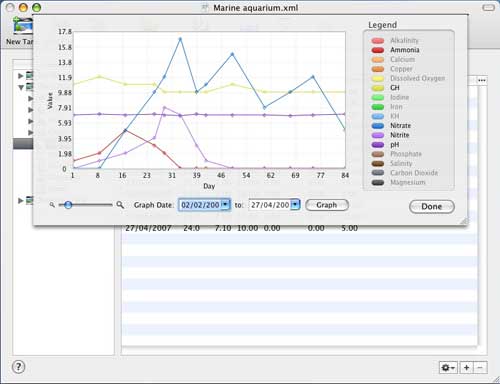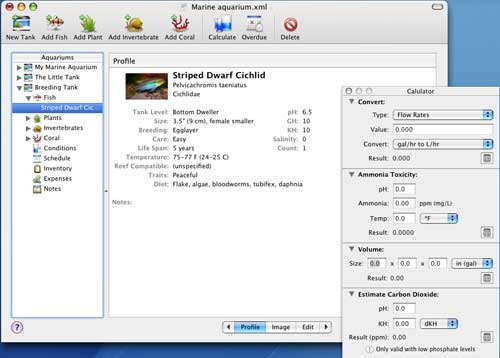
Maquarium 2.3.3
everyday software
Price: $24.00
http://www.everydaysoftware.net
Modern fishkeeping is a lot more complicated than putting a couple of goldfish into a bowl and hoping for the best. Even casual aquarists will spend hundreds of dollars on the livestock and hardware, and advanced hobbyists keeping marine fishes and corals will spend many times that. Maquarium is an integrated set of tools that allows aquarists to log water chemistry and quality tests, schedule maintenance events, download and record information, and perform a variety of useful calculations. Of course, almost all of the features that Maquarium totes could be done with other applications, and arguably in some cases better and with more flexibility, but what Maquarium does provide is a neat interface and true ease of use.
The usual way to start using Maquarium is by creating a Tank Profile. This is essentially pretty straightforward: you press the New Tank button, type in the name and “size” of the aquarium, and of you go. But what is slightly disappointing is that creating New Tanks lacks any sort of error-checking or intelligence. You can, for example, type anything you want into the Size field because Maquarium doesn’t use that value for any of its calculations or processes. Furthermore, while you are presented with a pull-down menu that allows you to configure over a dozen different water chemistry parameters, this doesn’t mean you can set all of them at this point. By the time you OK one of these options, the New Tank window closes, and you have to set all the other parameters in the main window one a time, using an almost identical window to the New Tank window. Setting these parameters is also vaguely annoying because you can’t enter them quickly by tabbing between fields or some other easy shortcut. Instead you have to double click on each one, type in the number, set its preferences, close the window, and then repeat as required. For what is basically all about filling the cells in a spreadsheet, this is far too much clicking and very annoying after a while.

Adding new aquaria is intuitive and easy, but inflexible and a little clunky.
While on the subject of water chemistry parameters, another vague annoyance is the use of “deviations” from a single value rather defining upper and lower values for that parameter. To be fair, this is a semantic difference in many cases: setting the pH to 7.5 +/- 0.5 is essentially the same thing as setting a pH range of 7.0 to 8.0. But often aquarium books will quote values across a range rather than by deviations, and so a little mental juggling of the numbers will be required to convert between what you’re reading and what Maquarium wants. However, in other cases using deviations is simply nonsensical. In a marine aquarium for example, the maximum safe concentration of nitrate is around 20 mg/l but the preferred level is 0. Setting the parameter is 0 +/- 20 mg/l is obviously nonsense since you can’t have -20 mg/l of nitrate, and setting the parameter to 10 +/- 10 mg/l would be equally bogus since 10 mg/l isn’t the optimal value but merely one not quite so bad as 20 mg/l.
Each aquarium added to the system appears in the left hand column with an adjacent disclosure triangle that when flipped reveals a number of useful options on the right hand side of the window. The first four are for fish, plants, invertebrates, and corals. The user can access an online database to download “index cards” for whichever organism is being added, or else create their own and perhaps upload that to the database for other Maquarium users to enjoy. On the plus side, this approach is flexible and being able to use pre-existing cards does make it very easy for aquarists to add information to their Maquarium database. The database format itself is restrictive, unrealistically limiting things like preferred pH and salinity to single values rather than ranges. The data hasn’t really been edited in any meaningful way either, and there are errors. For example, the egg-laying pufferfish Arothron nigropunctatus has its name spelt incorrectly on the card and is listed as a livebearing fish. So while definitely a useful feature, this is one to use with caution.

Water quality and chemistry parameters can be logged and plotted.
Another option allows the user to log water conditions. The usefulness of this will vary somewhat depending on the aquarist. Most freshwater aquarists will have little use of this except while “cycling” the aquarium, but marine aquarists will certainly find value to being able to plot some of the more critical parameters. This is especially true if hardware is being tested out or upgraded, where any changes to certain parameters will want to be recorded and critiqued. When compared with the tedious data entry system used when setting up a new aquarium in Maquarium, entering water parameters here is easier because you can simply double click fields and type in the number. You can’t tab between fields though, so there’s still a lot more mouse dragging and double clicking than would be ideal. Optionally, Maquarium can be set to give a warning if water parameters fall outside some predefined safe zone. Once data is entered, graphing is easily accomplished by choosing Graph Entries from the gearwheel menu at the bottom of the window. The resulting graph is easy to read and resizable, and the data itself can be exported as a comma delimited text file for analysis in a spreadsheet program like Excel. A couple of minor annoyances here are that there’s no keyboard shortcut for accessing the graphing mode, and that each time you graph the data, you have to select the range of dates required. Two bigger annoyances are firstly that you cannot export the graph as a graphics file, and secondly that the gaps in the data aren’t represented by gaps in the graph but by interpolated values. In other words, even if you have a blank in your data set, Maquarium “guesses” a value and adds it to your chart.
The Schedule option sets Maquarium to alert the user when prescheduled tasks are due, though it should be noted that it only does so if the application is running. Maquarium has only very limited integration with iCal, basically only adding single events without alarms rather than recurring events with alarms. As any fishkeeper knows, the main thing with tasks like water changes isn’t precisely when you do them, but that you do them regularly, so a way of adding, say, weekly alarms for water changes to iCal would be a great improvement. Much more robust is the set of calculator tools. These will do things ranging from the generic, like calculating aquarium volumes, through to the more specialized, such as estimating the amount of carbon dioxide needed for a planted aquarium with a certain pH and carbonate hardness level.

Fish “index cards” and a useful calculator round off the set of tools nicely.
Additional options allow the user to add expenses, inventory lists, and other notes. While the interface is intuitive and easy to use, it does become a bit cluttered. You cannot remove unwanted option fields or buttons from your tank data sets. So freshwater aquaria are lumbered with a corals section and fields for adding things like salinity, for example. This minor niggle aside, the application is otherwise colourful and attractive. Maquarium is essentially a Swiss Army Knife program: it does a large number of tasks, though in some cases not especially well, but is nonetheless useful and effective. Excel junkies will probably find Maquarium somewhat slow and limiting, but most other users will far prefer Maquarium’s simpler interface and highly focused toolset. Given the wide variety of things it does, it is also very good value for money, especially when set against the cost of building and maintaining a marine aquarium. For any Mac-owning aquarist, Maquarium is definitely well worth downloading and trying out.
Pros: Fairly intuitive and generally easy to use. Online database for quick access to species facts and requirements. Calculation and conversion tools useful. Neat graphing utility.
Cons: Alerts only work when Maquarium is running. Online database contains errors.
System requirements: Any PPC/Intel Macintosh running Mac OS 10.3.9 or higher
MyMac.com Rating: 3 out of 5

Leave a Reply
You must be logged in to post a comment.